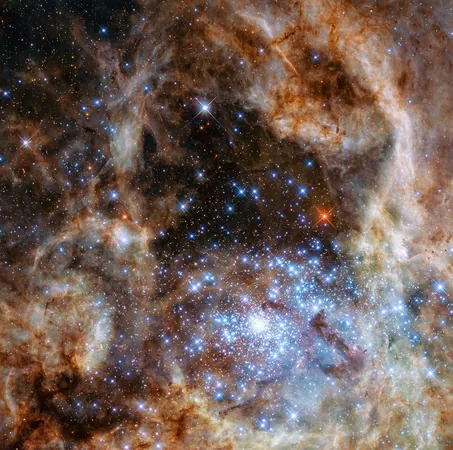
Prepare for Cosmic Discovery: The Habitable Worlds Observatory's Quest for Gigantic Stars!
2025-07-15
Author: Benjamin
Unveiling the Universe's Hidden Giants
Very massive stars (VMSs) are the celestial titans that have significantly shaped our universe, yet they are shockingly rare. With only about 20 known specimens scattered across the Milky Way and the Large Magellanic Cloud, these giants pose a unique challenge for astronomers.
A Telescope with a Vision: The Habitable Worlds Observatory
According to groundbreaking research by Fabrice Martins and a team of international experts, the forthcoming Habitable Worlds Observatory (HWO) could be the revolutionary tool we need to uncover these elusive VMSs. Their study has generated excitement in the astronomical community, published on the arXiv preprint server.
The Brilliance of Giants: What Makes VMSs Unique?
VMSs are colossal, often hundreds of times larger than our sun, radiating incredible brightness and demonstrating extraordinary mass-loss rates. These characteristics make them vital catalysts for enriching the galaxy with 'metals'—elements beyond hydrogen that form the core of planets, asteroids, and moons. Yet, VMSs typically reside within dense star clusters, blended among numerous ordinary stars, complicating their identification.
HWO: The Solution to a Stellar Mystery
The technology behind the HWO promises to elevate our search efforts, offering astonishing angular resolution of around 5 milli-arc-seconds (mas). This precision allows astronomers to spot individual stars in star clusters, where VMSs usually reside. To confirm an individual star's classification as 'very massive,' astronomers will analyze its optical and UV spectra—an area where the HWO excels.
Spectral Secrets: Crack the Code of Massive Stars
To distinguish between VMSs and other massive stars like Wolf-Rayet stars, astronomers will focus on key spectral lines such as HeII 4686 and CIV 5801-12. Each spectral feature unlocks the distinction between these star types, helping us understand their lifecycle and evolution.
The Race Against Time: Understanding Stellar Lifecycles
VMSs are not long for this universe. With lifespans of a mere few million years, they will ultimately either collapse into black holes or explode as supernovae. Their short existence highlights the urgency in capturing crucial data on their behavior and development, which could illuminate how planets and smaller stars form.
A Bright Future: Hopes for Galactic Exploration in the 2040s
Despite the challenges ahead, the astronomical community is abuzz with anticipation for the HWO, potentially launching in the early 2040s. Scientists are eager to explore these pivotal stars that hold the keys to understanding cosmic evolution. The race is on!









 Brasil (PT)
Brasil (PT)
 Canada (EN)
Canada (EN)
 Chile (ES)
Chile (ES)
 Česko (CS)
Česko (CS)
 대한민국 (KO)
대한민국 (KO)
 España (ES)
España (ES)
 France (FR)
France (FR)
 Hong Kong (EN)
Hong Kong (EN)
 Italia (IT)
Italia (IT)
 日本 (JA)
日本 (JA)
 Magyarország (HU)
Magyarország (HU)
 Norge (NO)
Norge (NO)
 Polska (PL)
Polska (PL)
 Schweiz (DE)
Schweiz (DE)
 Singapore (EN)
Singapore (EN)
 Sverige (SV)
Sverige (SV)
 Suomi (FI)
Suomi (FI)
 Türkiye (TR)
Türkiye (TR)
 الإمارات العربية المتحدة (AR)
الإمارات العربية المتحدة (AR)